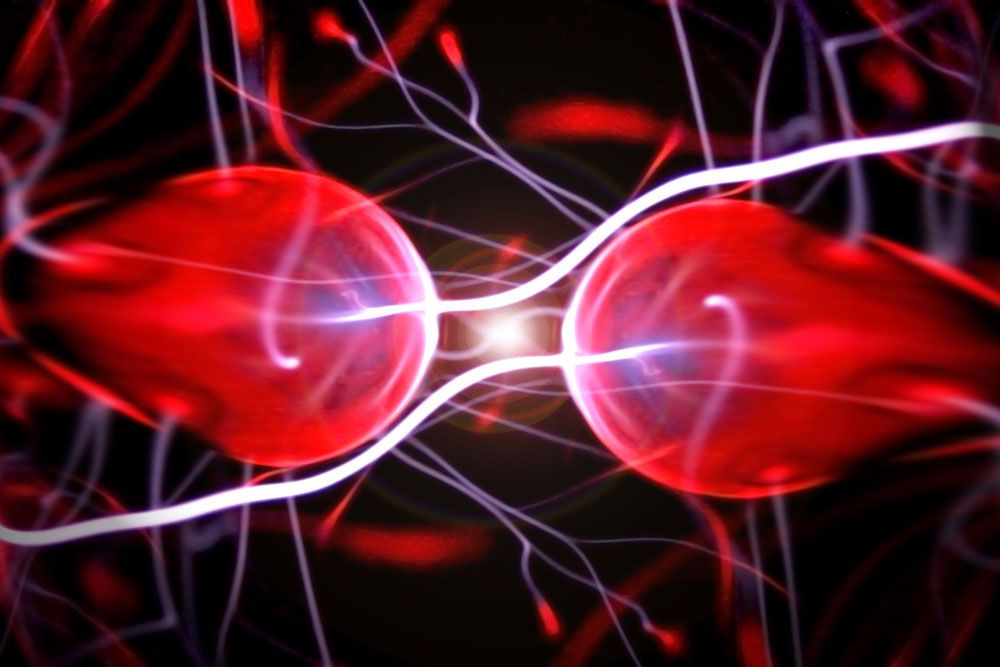
The question of why humans, the Earth and the universe exist will have to wait, at least for a little while.
A massive underground particle detector has so far failed to find evidence that mysterious subatomic particles, known as neutrinos, can act as their own antiparticles and annihilate each other.
"We haven't seen anything yet," said study co-author Michael Marino, a physicist at the Technische Universitaet Muenchen in Germany.
If neutrinos are their own antimatter partners, it could help explain a fundamental mystery of the universe: Why matter exists at all. [5 Elusive Particles That May Lurk in the Universe]
Too much matter
The universe is made up of tiny subatomic particles, and every matter particle has an antimatter partner with opposite properties. When particles and their antiparticles meet, they annihilate each other in a burst of light.
Current thinking holds that right after the Big Bang that formed the universe, only energy existed, but as the universe cooled, matter and antimatter were produced in equal parts.
Sign up for the Live Science daily newsletter now
Get the world’s most fascinating discoveries delivered straight to your inbox.
If the predictions of the Standard Model — the dominant theory of particle physics that explains subatomic particles — were correct, "you'd expect to produce equal amounts of matter and antimatter," Marino told Live Science.
These particles would have annihilated each other and created a sea of photons, or particles of light, leaving almost no matter behind to form stars, galaxies and everything else, Marino said.
But most of the universe consists of matter, and antimatter is relatively rare, leaving a great big question: Why?
Elusive interaction
To explain the presence of matter, many physicists have returned to an idea first proposed in the 1930s by Italian physicist Ettore Majorana. He wondered whether neutrinos — tiny, chargeless subatomic particles that rarely interact with matter — act as their own antimatter.
If neutrinos did do that, making them so-called Majorana particles, then theoretically physicists should find traces of a process called neutrinoless double beta decay. In that decay, an unstable atom's nucleus (or the atomic core that contains protons and neutrons) sheds two neutrons, which then convert to protons by releasing two electrons and two antineutrinos. If neutrinos are their own antiparticles, then the ghostly particles should sometimes annihilate each other, leaving only two electrons behind.
Researchers at the Enriched Xenon Observatory (EXO-200) in New Mexico have spent two years searching for this decay.
The detector is essentially a large vat of 440 pounds (200 kilograms) of xenon, charged with a huge voltage. The detector has a large fraction of radioactive xenon-136, an unstable form of the atom with a different number of neutrons than ordinary xenon. The gigantic detector is located about 2,100 feet (650 meters) underground; that way, the Earth can absorb cosmic rays from space that mimic the elusive decays and would thus interfere with the experiment, Marino said.
Whenever a xenon-136 nucleus decays, it produces a flash of light and charge in the detector. By analyzing where those flashes occur and how much energy is released, the team can detect, with a high degree of certainty, whether a neutrinoless double beta decay has occurred.
Other models
The new study doesn't completely rule out the possibility that neutrinos are their own antiparticles, but does make it less likely. In the last two years, the EXO-200 has detected more than 60,000 beta decays, none of which have the energy signature expected of neutrinoless double beta decay.
If the decay does exist, it must happen so infrequently that "the half-life of this decay is really quite long, a million billion times the age of the universe," Marino said.
Several other experiments will continue to hunt for evidence that neutrinos are Majorana particles, he added.
But Majorana neutrinos aren't the only way to reconcile the Standard Model with the abundance of matter in the universe. Physicists are also looking for traces that the distribution of positive and negative charge in a neutron is skewed, leading to what's called an electron dipole moment, Marino said.
Physicists have yet to find traces of that, either, he said.
"Everything looks really hunky dory," Marino said.
The new results were published Wednesday (June 4) in the journal Nature.
Follow Tia Ghose on Twitter and Google+. Follow Live Science @livescience, Facebook & Google+. Original article on Live Science.

Tia is the managing editor and was previously a senior writer for Live Science. Her work has appeared in Scientific American, Wired.com and other outlets. She holds a master's degree in bioengineering from the University of Washington, a graduate certificate in science writing from UC Santa Cruz and a bachelor's degree in mechanical engineering from the University of Texas at Austin. Tia was part of a team at the Milwaukee Journal Sentinel that published the Empty Cradles series on preterm births, which won multiple awards, including the 2012 Casey Medal for Meritorious Journalism.












